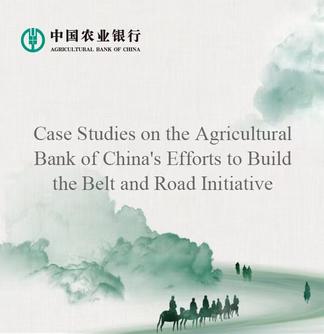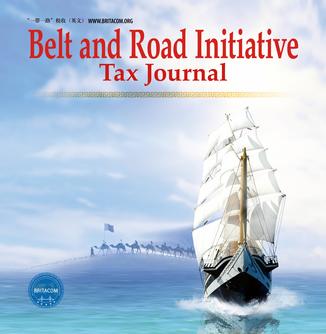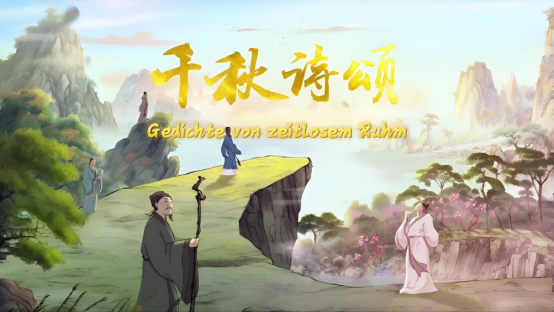
Screenshots of "Poems of Eternal Glory" shown on media in Germany, Italy, Brazil and other countries (Photo provided by CMG)
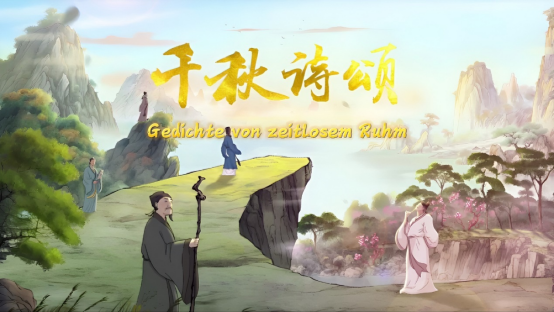
Poster of "Poems of Eternal Glory" in German (Photo provided by CMG)
After watching "Poems of Eternal Glory", the first animated series created by China Central Television (CCTV) through Chinese AI text-to-video technology, netizens from Germany, Italy and Portugal left comments:
"The video tells the story of an enduring friendship, which is both interesting and inspiring. The animation vividly conveys the essence of the poetry."
"The animation is well-made. I hope we can learn similar creative ideas in the future. I particularly like Chinese culture and know that many great poets like Li Bai and Du Fu emerged in the Tang Dynasty. Congratulations on creating such a meaningful program."
"China is a country with profound cultural heritage. Thank you for sharing this work."
Using AI to touch the pulsating cultural veins of a thousand years and achieve cross-temporal and spatial interaction is an opportunity for cultural protection and inheritance. With the use of artificial intelligence, the thousand-year-old civilization is no longer just dormant words in books, but can be presented in an animated scenario setting. By introducing interactive design, it can attract global audiences to feel and experience in the audio-visual sphere.
Artistry in Precision: Where Art and Technology Meet Each Other
Relying on the "CCTV Media Large Model" jointly developed by China Media Group (CMG), the parent of CCTV, and Shanghai Artificial Intelligence Laboratory as well as the text-to-video framework "Shusheng · Zhumeng", the animated series of "Poems of Eternal Glory" has achieved AI full-chain assistance from art design, motion effect generation to post-production, establishing a data tag system with Oriental aesthetic characteristics to ensure that the AI-generated images are, in terms of composition, color, imagery and other dimensions, fully reflecting Chinese aesthetics.
Entering the animated "Poems of Eternal Glory", crossing thousands of miles of mountains and rivers, before one's eyes are the flowing green mountains and ridges. With fluttering sleeves, one becomes a guest in a painting! AI has transformed the poems and verses of ancient people from "totems of history" into cultural phenomena and evolved from "symbols of memory" into visual art.
Starting from 2024, China Media Group has rolled out the "Poems of Eternal Glory" animated series in German, Italian, Portuguese, Spanish and other language versions, and broadcast them simultaneously to mainstream overseas media, covering multiple regions including Europe, Latin America and Africa. The audience, both at home and abroad, reached 1.2 billion people, among which nearly 100 million are from overseas. The number of views on overseas new media platforms has exceeded 6 million.
The technical team of "Poems of Eternal Glory" fed the AI model with a vast amount of ancient poetry and Tang Dynasty cultural relics data, enabling it to accurately capture aesthetic keywords such as "national style, freehand brushwork, and meticulous painting", and restore Du Fu's flowing long gown, the upturned eaves of Tang Dynasty architecture, and even the scene of "sunset glow mingling with solitary wild geese" from "Preface to the Tengwang Pavilion". According to the Shanghai AI Laboratory, the collaboration with CCTV verified the potential of AI in cultural inheritance, indicating that "Technology has brought poetry to life, which is a mutual pursuit of art and technology."
AI Sculpts Soul of Poetry: Embarking on Cultural Journey across Time and Space
Riccardo Giovannetti, the chief editor of the Agenzia Giornalistica Italia (AGI), said that "Poems of Eternal Glory" has created an engaging scene through artificial intelligence technology, allowing the audience to experience the charm of poetry creation in ancient China 1,400 years ago in an atmosphere of ancient China. It is commendable to spread Chinese culture to the Italian public in the form of such an AI animated film.
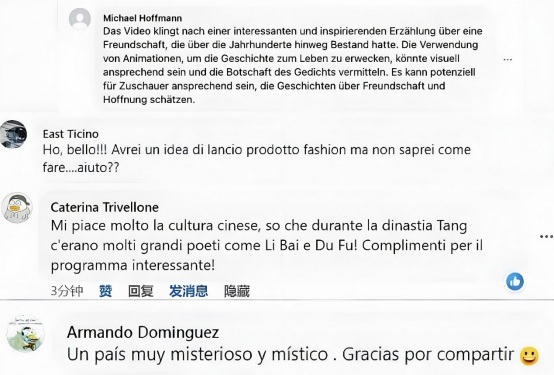
A screenshot of feedback from international audiences watching "Poems of Eternal Glory" (Photo provided by CMG)
Bacar Camara, the chief editor of the National Radio of Guinea-Bissau, said that this AI animated series will help the people of Guinea-Bissau better understand China and Chinese culture.Lin Dahua, the technical director of "Poems of Eternal Glory" and a leading scientist at the Shanghai AI Laboratory, said that on the "CCTV Media Large Mode · AIGC Animation Production" interface, by uploading a "reference style image" of a young man from the Tang Dynasty and then entering "Chinese style, Tang Dynasty, middle-aged, refined, male, light green clothes" in the "concept design description" text box, an animated character image that matches these prompts will appear on the screen in just a few seconds.
Take "Thoughts on a Silent Night" as an example. AI uses light and shadow rendering and dynamic composition techniques to transform "the bright moon" into a globally understandable "homesickness" image, achieving cross-cultural expression of the poetic scene. "Farewell to Dong Da" is presented in a watercolor style, with a focus on the characters. The animated characters that appear are both male and female, wearing different styles of Tang Dynasty clothing. The furniture and utensils in the animated film are also made in accordance with the characteristics of the Tang Dynasty, featuring Tang Dynasty "Seven-star Plate" tea sets and incense burners modeled after the carved honeysuckle pattern five-legged silver incense burner in the Shaanxi History Museum.
After its launch, "Poems of Eternal Glory" has widely been praised as a successful contemporary expression of technological confidence and cultural awareness in China. It deeply integrates AI with Chinese aesthetics, using the power of technology to rebirth the thousand-year-old cultural heritage in models and reconstruct it in algorithms. Just as the scenes presented in "Poems of Eternal Glory" show, artificial intelligence is giving new life to Chinese classical poetry and presenting Chinese traditional culture to the world in a more three-dimensional, vivid, and charming way. (By Luo Hao)




 A single purchase
A single purchase

